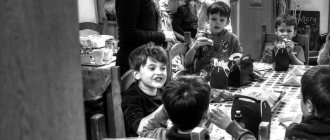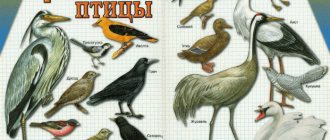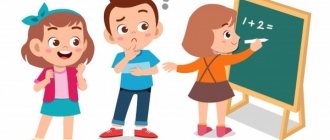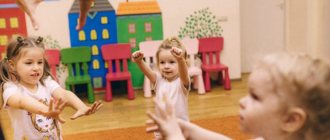COLLECTION OF FAIRY TALES FOR FAIRY TALE THERAPY
WITH PRESCHOOL CHILDREN
The value of fairy tales for psychotherapy, psychocorrection and the development of a child’s personality lies in the absence of didactics in fairy tales, the uncertainty of the location of the characters’ action and the victory of good over evil, which contributes to the psychological security of the child. The events of a fairy tale flow naturally and logically from each other. In this way, the child perceives and assimilates the cause-and-effect relationships that exist in the world. When reading or listening to a fairy tale, the child “gets used to” the story. He can identify himself not only with the main character, but also with other characters. At the same time, the child’s ability to feel in the place of another develops. This is what makes fairy tales an effective psychotherapeutic and developmental tool.
The therapeutic effect is getting used to sleep in kindergarten.
Children's age: 2-5 years.
Fairy tale for fairytale therapy for preschool children:
"DREAM OF THE BOLD"
Kolobok lived with his grandparents. He was obedient, and therefore did not run away from them. Every morning Kolobok rolled along the path to kindergarten. There he played with friends, had fun, sang everyone his favorite song about himself, and when in the evening he returned back to his grandparents, he always told them what interesting happened to him today in the garden. Kolobok liked everything in kindergarten, except for one thing - he could not go to bed in the garden at lunchtime: he cried, was capricious, could not fall asleep for a long time, even tried to roll out of the crib and tried to roll from the kindergarten home to his grandparents. But one day his teacher, Lisichka, managed to stop him on the threshold of the kindergarten in time and bring him back to the group. She put Kolobok back in a comfortable crib, covered him with a warm blanket and asked.
- Why don’t you, Kolobok, like to sleep in the garden?
“Because it’s so sad, lying in a crib with your eyes closed and not seeing anything.” This is so not interesting!
- Don’t just lie there, but try to fall asleep so you can see interesting dreams! - The fox said affectionately.
- Dreams? I don't know what dreams are. I never dream about them.
“Lie down more comfortably and I will teach you to dream…” said the Fox.
Then the teacher Lisichka advised Kolobok not just to lie in his crib with his eyes closed, but to relax, feel how warm and comfortable his crib is and try to dream about something pleasant.
Kolobok closed his eyes and tried to do everything as the Chanterelle told him. And a miracle happened - he fell asleep and had a good dream. He dreamed of a cheerful bunny who was jumping with him, then the Wolf played the game “Catch Me” with him - and they had a lot of fun, then Mishka danced with him to joyful, cheerful music. Kolobok also dreamed of his teacher Foxy; in his dream she was as kind and friendly as in reality. She played hide and seek with him. And then Kolobok with all the animals: a bunny, a wolf, a bear and the teacher Lisichka took hands and danced a cheerful round dance in a circle. Kolobok had such a good dream.
When he woke up, he was in a cheerful and cheerful mood. He immediately told the teacher and all the animals in the garden his fascinating dream.
Since then, Kolobok looked forward to lunch in kindergarten in order to have a new interesting dream.
The therapeutic effect is a complicated adaptation of the child to the conditions of kindergarten.
Children's age: 2-5 years.
Fairy tale for fairytale therapy for preschool children:
"FISH BULL-BULL"
There lived in the sea a little fish called Bul-bul. Every morning she sailed to the sea kindergarten, but she was very sad, she often cried because she didn’t want to make friends with anyone, she was not at all interested in the sea garden and all she did was cry and wait for her mother will come and take her home.
There was a teacher in this garden, but she was not an ordinary fish, but a gold one. That's what her name was - teacher Golden Fish. And then one day she said to the little fish Bul-bul:
“I’ll help you, I’m a magical Goldfish and I’ll make sure you don’t cry in kindergarten anymore, so you don’t feel sad.” The teacher goldfish waved its tail - and a miracle happened - the Bul-bul fish stopped crying, she made friends with the other little fish in the group and they played, laughed and frolicked together in the sea garden. Bul-bul was even strange - why didn’t she notice before how friendly the fish were next to her in kindergarten and how fun and interesting it was to spend time with them!
Since then, Bul-bul happily sailed to the kindergarten every morning, because she knew that her friends were waiting for her there.
The therapeutic effect is a positive attitude towards visiting kindergarten.
Children's age: 2-5 years.
Fairy tale for fairytale therapy for preschool children:
"A BUNNY IN KINDERGARTEN"
Mother Hare lived in a fairytale forest and she was the happiest in the world, because she gave birth to a little hare. She named him Fluffy. Mom loved her bunny very much, never left his side for a minute, walked, played with him, fed him delicious cabbage, an apple, and when he started crying, instead of a pacifier, mom gave him a juicy carrot and the bunny calmed down.
Time passed and Fluffy grew up. Mom decided to take him to the forest kindergarten, to which all the small animals of this forest went. And then one day, my mother brought her bunny to kindergarten. Fluffy burst into tears, he was scared and sad without his mother, he did not want to stay there. The teacher, the red-haired Squirrel, approached our bunny. She was good and loved all the small forest animals very much. The squirrel took him in her arms and gently pressed him against her fluffy fur coat. The teacher took pity, calmed the bunny down and introduced him to other little animals who went to kindergarten. She introduced him to a little cheerful fox, a kind bear, a friendly hedgehog and other animals.
All the little animals were very happy that a new one appeared in their forest garden - a bunny. They began to play games with him, walked on the green lawn, then ate and rested in their beds. And so the mother came for the little bunny to take him home. How happy she was when she saw that her bunny was not crying, but was playing happily in the garden! All the way home, Fluffy told his mother who he met in the garden, and how interesting and fun it was for him to play with his new friends. Mom was proud of her bunny and was glad that Fluffy understood that there is no point in crying in kindergarten, because it is not scary at all, but on the contrary, it is fun and interesting.
The therapeutic effect is a decrease in the child’s fear of doctors and injections.
Fairy tale for fairytale therapy for preschool children:
“ABOUT VIRUSES AND VACCINATIONS”
This happened a very long time ago. A monster settled in a large warm swamp. There was no peace for people from him. People went to Ivan the hero to ask for help. And Ivan the hero went and fought with the monster. They fought for three days and three nights. Finally, Ivan the hero won.
To take revenge on people, the Monster, dying, spat out entire hordes of small, hunched, aggressive aliens - viruses. They spread all over the world, penetrated the bodies of adults, children, animals and caused a very serious and dangerous disease - influenza.
Many people and animals became seriously ill from the flu because they did not know how to protect themselves, how to protect themselves. This happened in ancient times, but, unfortunately, these evil viruses are very stable and tenacious.
They still live today - in the bodies of sick people, on books, toys, dishes and other things that the patient used.
With saliva, germs land on the sidewalk or ground. When saliva dries, viruses become feather-light, rise into the air with dust, and enter the human body through breathing.
Viruses most often settle in the lungs, where they feel warm and comfortable. They begin to feed intensively and reproduce. These evil viruses want everyone to get sick.
But I want to reassure you, not everyone gets sick! Those who care about their health and always follow the rules of hygiene, and in particular, always wash their hands, need not be afraid - they are not afraid of the flu.
And people came up with a vaccine to treat these terrible viruses, which is done by doctors. This vaccination kills all these hordes of evil viruses and people stop getting sick from the flu.
The therapeutic effect is a reduction in the child’s fear of the dark.
Children's age: 2-5 years
Fairy tale for fairytale therapy for preschool children:
"IN THE DARK HOLE"
Two friends, Chicken and Duckling, went for a walk in the forest. On the way they met Chanterelle. She invited her friends to visit her, in her hole, promising to treat them with delicious sweets. When the kids came to the Fox, she opened the door to her hole and invited them to go in first.
As soon as the Chicken and the Duckling crossed the threshold, the Fox quickly closed the door and laughed: “Ha-ha-ha! How cleverly I deceived you. Now I’ll run for wood, light a fire, heat some water and throw you kids into it. Now I’ll have some delicious soup.”
Chicken and Duckling, finding themselves in the dark and hearing the Chanterelle's ridicule, realized that they were caught. The chicken burst into tears and began to loudly call his mother, because he was very scared in the dark.
And the Duckling, although he was also very afraid of the dark, did not cry, he thought. And finally I came up with it! The duckling suggested that the chicken dig an underground passage. They began to rake the earth with their paws with all their might. Soon a ray of light penetrated the small gap, the gap became larger, and now the friends were already free.
“You see, Chicken,” said the little Duckling. - If we sat and just cried because we were scared to sit in the dark, the fox would have already eaten us. We must always remember that we are stronger and smarter than our fears, and therefore we can easily cope with them! The Chicken and the Duckling hugged each other and ran home joyfully.
The Fox came with firewood, opened the door, looked into the hole and froze in place in surprise... There was no one in the hole.
The therapeutic effect is a reduction in the child’s anxiety about the fear of the dark.
Fairy tale for fairytale therapy for preschool children:
“WHY IS SEREZHA NOT AFRAID TO FALL ASLEEP BY HIMSELF?”
Little Seryozha was lying under the blanket and trembling all over. It was dark outside. And it was dark in Seryozha’s room too. Mom put him to bed and slept in her room. But Seryozha could not fall asleep. It seemed to him that there was someone in the room. The boy thought he heard something rustling in the corner. And he became even more scared and was even afraid to call his mother.
Suddenly a bright celestial star landed right on Serezha’s pillow.
“Seryozha, don’t tremble,” she said in a whisper.
“I can’t help but tremble, I’m scared,” Seryozha whispered.
“Don’t be so afraid,” said the star and illuminated the whole room with its twinkling. - Look, there’s no one in the corner or under the closet!
- Who was that rustling?
“No one rustled, it was fear that got into you, but it’s very easy to drive it away.”
- How? Teach me,” the boy asked the bright star.
- There is one song. As soon as you get scared, start singing it right away! - So said the star and sang:
A terrible little fear lives in the dark forest,
He lives by the swamp in the dark bushes.
And the terrible little fear does not appear from the forest,
He is afraid of the light and sits in his bushes.
And he is also afraid of laughter, a terrible little fear,
As soon as you laugh, fear disappears in the bushes!
First, Seryozha listened to the star’s song, and then he sang with her. It was then that the fear disappeared from Seryozha’s room, and the boy fell asleep sweetly.
Since then, Seryozha is not afraid to fall asleep in a room without his mother. And if fear suddenly comes to him again, a magic song will help!
The therapeutic effect is to show the child the other side of excessive moodiness and harmfulness.
Fairy tale for fairytale therapy for preschool children:
"A TALE ABOUT THE SUN"
In a galaxy far, far away, many millions of light years away from us, there lives the Sunshine family. Big Sunny is dad, smaller Sunny is mom, little Sunny is son and tiny Sunny is daughter. They all live as a friendly family. They read together and come up with strange stories.
Each of them, from birth, has his own job, which he performs constantly without breaks or vacations - they illuminate and warm the planets that revolve around each of them. And everything would be fine, but Sonny Sunny was famous for his capriciousness: he is capricious, says “I don’t want”, “I won’t”...
Does this happen to you?
Mom and dad don’t know what to do, how to explain to their son that such behavior is not appropriate for Sunny, because being Sunny is a great honor, but at the same time, it’s also a great responsibility—after all, life on the planets depends on you. Where there is responsibility, there is no place for harm.
Sonny Sunny was capricious today too:
- I don’t want to shine from the right, I don’t want to stand in one place for so long, I don’t want to get up so early... I’ll take it and won’t shine on the planet Cyprana, where living beings live. I'll turn away!
And Sonny Sun turned away from the Cyprians, and it became dark and dark there. All the residents were scared. What will happen to them next? If the sun doesn’t shine, then plants, vegetables and fruits don’t grow, and when there’s no harvest, then there’s nothing to eat. And without food, as everyone knows, a living creature dies. Little children from Cyprus began to cry, because they were very afraid of the dark - it seemed that monsters or something terrible would attack them. But they didn’t know that in fact, almost all monsters are also afraid of the dark.
The Cypriots did not wait for death, they gathered everyone for a meeting and began to talk about how they should continue to live and what to do so that the Son of the Sun would shine on their planet again. These Cyprians are strange creatures. They had bulging eyes on their chin, a breathing and sniffing nose on their stomach, and a talking and eating mouth on their back. And they thought of solving the problem like this: they need to film a request to Sunny on a video camera. To do this, they took the last lanterns, gathered the children and all together told their son Sunny how hard it was for them to live without him. The children, crying, told about their fears. Then, the bravest ones launched a rocket and flew towards the Sun. We flew for several days to convey the request.
Sonny Sunny watched the recording (he loved watching cartoons), but this recording turned out to be sad. Sunny felt ashamed of his behavior and whims. He even burst into tears along with the Cyprian children, who were so afraid of the dark.
Since then, Sonny Sun has shone on all the planets in his system and has not been capricious, but obeyed his father and mother.
What a great guy, Sonny Sunny!
Are you also not capricious and obey your parents?
The therapeutic effect is to teach children to go to the toilet before bed.
"WET FAIRY"
In one magical country under the strange name of Neverland lived a boy Roma. When he went to bed, the Wet Fairy flew into his dreams to play. She was so much fun! Together they could fly to another planet, travel to Niagara Falls, or simply sit by the Kuban River with their feet in the water. In a dream, one could order different seasons. And Roma often ordered summer. And the Wet Fairy also loved summer.
They called the Wet Fairy because she looked like a snail and left a wet trail behind her. And, of course, she liked water. She loved swimming more than other entertainments.
When Roma woke up, the bed was always wet. And for some reason the adults thought that it was the baby himself who did not reach the toilet and made a puddle in the bed. And indeed, this is how it all looked, and nothing can be done about it. But Roma was a smart boy and decided the next time the Wet Fairy arrived to talk to her about wet footprints. So I did. And this is what he heard from her:
“I’m sorry that I’m causing you “wet” trouble.” Sorry, but I love playing with you in my dreams! What do we do?
Roma answered her:
- From now on, let's play in the bathroom, where you can play with water.
“Come on,” said the Wet Fairy and added, “and before you go to bed, Roma, don’t forget to go to the toilet.” And when during our trip you want to go to the toilet, just say so, and we will return home, and then continue the games.
“Okay,” Roma answered.
And you, children, to whom the Wet Fairy flies in a dream, remember: before going to bed, be sure to go to the toilet.
And when you dream that you want to go to the toilet, wake up, check (pinch yourself) to understand that this is not a dream.
Get out of bed, walk to the toilet, find the toilet and then... do your wet business.
Therapeutic effect - teaching children to keep their promises and fulfill responsibilities
What stories should not be read to your child before bed - tips
Of course, your child should not read “scary” fairy tales before going to bed. The child's psyche is too mobile. And the imagination is so rich that kids can see with their own eyes the immortal Koshchei, the evil witch or Baba Yaga.
The dreams of young children depend largely on the information they receive before falling asleep. Therefore, the plots of fairy tales should be good and, of course, end well. Fairy tales should lull a child to sleep, so they need to be read in a quiet, calm voice.
Fairy tales for our little children are a kind of “encyclopedia” of life, through which they learn different models of behavior and begin to understand “what is good?” and “what is bad?” And the older a child becomes, the more knowledge he draws from books, the wider his vocabulary becomes. He learns new words, compares the behavior and actions of fairy-tale characters, learns to think and reason. No wonder A.S. Pushkin said that reading is the best teaching!
"PROMISE"
Artem lives in the neighboring yard. He is a good and friendly boy and goes to kindergarten every day. He likes to eat candy, swing on swings, slide down slides, ride a scooter, ride a bicycle and many other interesting things, in a word, everything that you like to do.
It so happened that Artem got sick and stayed at home with his dad. He coughed a lot and had a high fever. In a few days, taking medication, the guy almost recovered. Dad stayed with his son all the time because he worked at home on the computer. Mom had to go to work every day.
At home, Artem had a lot of different toys, in three bags. When it was time to play, or friends came to visit, Artyom took toys out of bags and played. But after the game everything had to be put back in place. This is how the boy's mother and father taught him. And Artemka didn’t always want to put away toys, perhaps just like you...
On the last day of his illness, Artem played with toys from the very morning. Before going to work and leaving her son at home with his dad, his mother reminded him not to forget to put his toys in bags before bedtime. The son promised to fulfill the request. But when lunch came, dad was very busy with work, so Artyom ate himself and, forgetting about the promise, went to bed, the toys remained scattered on the floor.
Waking up, the boy ran to the toys. And how surprised he was, how disappointed he was when he didn’t find one. Artem even started crying. He ran to his father and told him what happened. Dad reassured his son and suggested that he think about it. They thought and talked for a long time and came to the conclusion that the toys left Artyom because he did not fulfill his promise.
We need to return the toys! But how to do that? Dad suggested finding a “lost things” site on the Internet and reviewing the list to find toys. And so they did. We found toys that ran away from the boy. Artem was simultaneously glad that the toys were found, and sad because he did not keep his word... The question arose: “How can I get them home now?”
- Let's write a letter to "lost things." In it, you need to apologize to the toys and promise to keep your promises,” dad suggested. - Are you ready?
- Yes! - Artem answered.
— That same day, dad and son sent an email. And in the evening the doorbell rang. When dad opened it, we saw that all the toys were lying on the threshold. Artem was so happy!
- Would you be happy?
“From then on, Artyom collected the toys back into place without any reminders and remembered that promises must be kept.
- And you, children, also remember this rule!
Therapeutic effect – Reduce children's anxiety about the fear of the dark.
Fairy tales and stories to read before bed for children 2-3 years old - list
In modern society, the importance of Russian folk tales has increased more than ever. “New-fangled” authors very often write fairy tales that serve exclusively entertainment functions. As a result, the significance of fairy tales in the moral and spiritual education of children loses its relevance.
Some parents mistakenly think that all fairy tales are the same. But this is far from true. It is the Russian folk tale that conveys the wisdom of many generations and opens up truly limitless pedagogical opportunities for parents.
The main advantages of Russian folk tales:
- Captivating plot and depth of ideas.
- High educational orientation.
- Melodious, poetic language.
- Frequently repeated definitions that are easy for children to learn.
- Particularly dynamic storytelling.
- The texts are characterized by imagery and expressiveness.
- Folk tales are accessible and understandable for the youngest listeners.
- The Russian fairy tale fully reveals the philosophy, ethics and aesthetics of our people.
Russian folklore teaches children:
- Obedience.
- Mercy and tolerance.
- Friendliness.
- Sociability.
- Kindness.
- Diligence.
- Unselfishness.
- Hard work.
For example, the fairy tale “Teremok” introduces children to the concept of “friendship.”
The fairy tale "Geese and Swans" teaches love, obedience and responsibility. List of Russian folk tales, songs and nursery rhymes for children 2-3 years old:
- Turnip.
- Princess Frog.
- Cat, rooster and fox.
- Bubble, straw and bast shoe.
- Zayushkina's hut.
- Puff.
- Like a goat built a hut.
- Noble bear.
- Chatty bird.
- A pot of porridge.
- Boasting hare.
Russian folk nursery rhymes:
- Okay, okay.
- The bear is clubfooted.
- White-sided magpie.
- Early in the morning.
- Loaf.
- Some water, some water.
How to read a bedtime story to a child: tips
- For children aged two years, child psychologists recommend reading simple fairy tales at night, the main characters of which are animals. Fairy tales are perfect for evening reading: “Kolobok”, “Ryaba Hen”, “Teremok”.
- Child psychologists insist that fairy tales and nursery rhymes be told to children in a folk version. It is these three fairy tales that fairytale therapists recommend as mandatory reading at this age.
- It is not at all necessary to try to read a fairy tale in one evening. You can spread out reading it over several days. In this case, the two-year-old child will look forward to the continuation of the story. The age-old problem of putting your baby to bed will disappear by itself.
- While reading fairy tales, children two to three years old should pause, highlight certain phrases with their voice, and ask the child to repeat words and sentences. Experts say that at the age of two, children can already carefully follow the narrative and grasp the essence of the fairy tale.
At three years old, a child’s board books should include not only Russian folk tales, but also entertaining stories written by Russian classics and modern authors . For example: “Geese and Swans”, “Masha and the Bears”, “Tales of a Stupid and Smart Mouse” by S. Marshak, “Grandmother’s Garden” and “Apple” by V. Suteev, “The Tale of a Crib” by Tatyana Kholkina, “About Katyushkina’s Capriciousness” » Olga Bykova. Fairy tales should be written in simple and understandable language, the narrative should be easy to understand, and the ending of the tale should be positive. At the age of three, it is already possible and necessary to discuss with children what they have read, to ask their opinion about the behavior of this or that fairy-tale character.
The same fairy tale can (and, according to some experts, should) be read several times. That is, it is desirable for the child to remember the plot and be able to retell it himself.
List of fairy tales for three-year-olds:
- The Bremen Town Musicians.
- Little Red Riding Hood.
- Snow White and the Seven Dwarfs.
- The Tale of Vasilisa the Beautiful.
- Two greedy bear cubs.
- Three piglets.
- Three Bears.
Fairytale therapists recommend that parents of young children who are capricious before bed and have trouble falling asleep should adopt sleepy tales. These are short fairy tales that put children in the mood for sleep. For example: “The Tale of the Deer Who Couldn’t Sleep”, A. Prokofiev’s fairy tale “Hare’s Foot”, Iris Review’s fairy tale “How Tisha was looking for sleep”, “Lullaby Tale” by V. Postnikov. Many parents prefer to sing a lullaby to little children before bed. Unfortunately, not all mothers and fathers succeed in this flawlessly. Lullabies can be perfectly replaced by reading rhymed fairy tales.
List of rhyming lullabies for little ones:
- A lullaby about a sparrow.
- The fairy tale goes to bed with us.
- How they were looking for the sun. Shamonin-Versenev V.
- A star fell from the sky. T. Koval.
The best bedtime stories for children are considered to be the rhymed works of K. Chukovsky, S. Mikhalkov, E. Uspensky, S. Marshak.
AST Publishing House released the book “The Best Bedtime Stories,” which includes works by all these authors. At what age should children start reading fairy tales?
Fairytale therapists believe that children need to read nursery rhymes and short fairy tales from birth. Of course, the baby is unlikely to understand their meaning, but he will definitely rejoice when he hears his mother’s gentle voice. At one year old, children look at bright fairy-tale pictures with great interest and can already hold a book in their hands on their own. At two years old, children listen carefully to the text and respond to voice intonations. They are trying to understand the plot of a fairy tale. At three years old it is already difficult to find more grateful listeners.
"TERRIBLE FEAR"
In the dark forest lived little Scary Fear. And he was so interesting - he was afraid of everything himself. A branch will crack somewhere, and he will jump up and down. But every night he had to go into town and scare children - that was his job, and he did it politely. By the time he got there, he was sweating and shaking like a leaf in the wind, he was so scared.
Others were frightened by Fear so that they would not frighten him. But he didn't know that the others weren't going to scare him. Therefore, he continued his work and took his work responsibly. Conquering timidity, fear went into town every evening.
The city was filled with large, tall buildings, each containing 100 apartments. And every apartment where children lived had to be walked around and the kids had to be frightened by howling, flickering lights, or just black darkness. All the children began to be afraid. They hid under the covers, ran to each other's beds, turned on the light, or asked their parents to sleep with them. They imagined various horrors, monsters, monsters, cannibals.
A brave girl, Anya, lived in one of the apartments. She was tired of being afraid and hiding from fear. Although Anya was brave, she still felt uneasy. And one day she decided to find out what kind of fear it was that scared everyone. I took a flashlight and a stick with me to teach the one who haunts all the children in the evenings a lesson. She dressed in a dark raincoat and boots and went out into the entrance. After a while I saw a strange man. Or maybe not a little man, but a gnome. He stood in the middle of the yard so that it would be convenient to work and capture more of the windows of the children's rooms.
Anya noticed that Fear looked strange, was shaking all over and was constantly muttering something under his breath. He had short and withered arms, crooked legs, and a large fur hat on his head, although it was spring outside. This view made Anya feel sorry for this old grandfather, and not fear or horror. I even wanted to meet the old man.
Anya, like a well-mannered girl, took a step out of the darkness and said hello:
- Good evening, grandfather!
“Hello,” Fear the Terrible answered in fear and sat down on the ground, his legs refused to hold him up.
- What are you doing here at such a late hour? - asked Anya.
“I... I... I... am working...” answered Fear, stammering.
“Let’s get acquainted,” Anya continued boldly.
The thought flashed through Fear’s head that he would finally have a friend or just a person with whom he could talk and share his thoughts. They talked all evening, drank tea and cookies at Anya’s house. Fear Scary spoke about his difficult life and work.
Anya listened carefully and thought:
“It must be said that if I continued to be afraid and did not dare to take a desperate step, I would still be shaking in my crib under the blanket.” And so I met Fear, got to know him and became friends. I learned that Fear itself is not so scary, but even pleasant.
And how many interesting stories he knows about forest dwellers!
That night and many nights later the children slept peacefully. Fear the Terrible now worked as a storyteller. He really liked his job. The children waited for him and listened carefully to stories of adventures, and then calmly fell asleep.
Do fears live next to you? Try to get to know them.
The therapeutic effect is to show the child that each person is unique, therefore it is necessary to take care of yourself, love and perceive yourself as you are.






